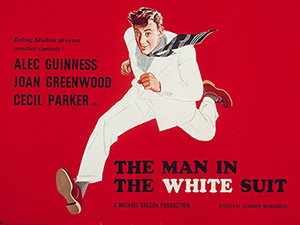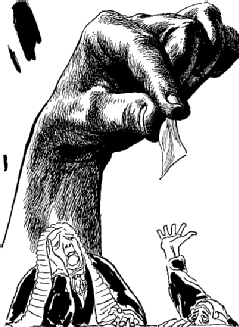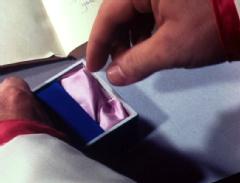Fabrics of the Future
Classic science fiction film and television has produced a stereotypical image of futuristic fashion as swathing us all in silver foil. However SF has explored many other possibilities for how clothing may evolve, given the fabric of the future.
Synthetic Futures
The first fully synthetic clothing polymer, Nylon, was announced in the late 1930s, and opened the door to clothing made from non-organic materials [1]. Nylon was initially released in the United States, and its distribution was rapidly redirected to war use, so it wasn’t until the late 1940s that the relatively durable and easy to care for fabric began to make a large impact in Europe.
 The Man in the White Suit was a 1951 British science fiction comedy film which provides an interesting commentary on contemporary society and its attitudes towards science. The story follows Sydney Stratton, a young research chemist who strives to create an indestructible fabric. Working in the fabric industry, his demands for expensive materials result in his repeated dismissal from different firms. Eventually employed as an unskilled worker at Birnley Mills, he coopts their research lab resources to continue his researches, ultimately creating an indestructible fabric and having a suit made from it - in luminous white, both because it is slightly radioactive and because it repels any dye.
The Man in the White Suit was a 1951 British science fiction comedy film which provides an interesting commentary on contemporary society and its attitudes towards science. The story follows Sydney Stratton, a young research chemist who strives to create an indestructible fabric. Working in the fabric industry, his demands for expensive materials result in his repeated dismissal from different firms. Eventually employed as an unskilled worker at Birnley Mills, he coopts their research lab resources to continue his researches, ultimately creating an indestructible fabric and having a suit made from it - in luminous white, both because it is slightly radioactive and because it repels any dye.
While having a science-fictional premise, the film is a satire of contemporary attitudes. Sydney Stratton’s striving for an indestructible material that will free humanity from the waste and labour associated with cleaning and manufacturing is portrayed as part of a naive faith in the positive impact of science, which is divorced from an appreciation of the realities of the world. While all the textile mills employ chemists and host research laboratories, their relationship with scientific innovation is ultimately ambivalent. The human reaction to Stratton’s invention is almost entirely negative: both factory owners and textile workers react with intense fear for their own livelihoods and attempt to suppress the discovery. Indeed it is only the ultimate failure of the material (which decomposes over time) that spares Stratton from a lynch mob.
 A similar fabric discovery is told from a very different point of view in “The Professional Approach”, a short story by Charles L Harkness and Theodore L Thomas (writing as Leonard Lockhard in Analog, September 1962). The narrator character here is a patent lawyer working with a chemical laboratory. They literally hand him a problem in the form of their new discovery:
A similar fabric discovery is told from a very different point of view in “The Professional Approach”, a short story by Charles L Harkness and Theodore L Thomas (writing as Leonard Lockhard in Analog, September 1962). The narrator character here is a patent lawyer working with a chemical laboratory. They literally hand him a problem in the form of their new discovery:
“He handed me a sheet of paper, snow-white in color. I put aside my pencil and notebook to examine it. As I took it in my hand it was obvious that it was something unusual. It was softer than a cleansing tissue, and probably even more flexible. I rubbed it between my fingers, and it had the most remarkable feel of any paper I had ever felt—soft and clinging and cool, and exceedingly pleasant.”
But this paper has an even more remarkable property:
“That paper has a tensile of 2,800 pounds per square inch, and a tear strength equally unbelievable."
I looked at the little sheet and great possibilities began to occur to me. "Clothing," I said. "Great heavens, think what this will do for the clothing industry. No more weaving. Just run this stuff off on a paper machine at five hundred feet per minute."
Given the possibility of an information leak, it’s clear this material must be patented as soon as possible. Unfortunately, in the usual course of events a vast range of experiments would be required to establish the limits of the patentable process. Instead the lawyer has to go into the chemistry theory and be intensively creative to determine every possible legal leverage and freedom in building his patent case.
As was the case with the White Suit, however, the potential of the material to revolutionise the clothing industry might well have a significant flaw.
 A more positive view of the future of fabric - but one still at the mercy of industrial espionage - can be found in the television series Thunderbirds (1965-6). Co-creator Sylvia Anderson was famously credited in the television series Thunderbirds and UFO for her “21st Century Fashions”, and had an important role in defining the characters and their distinctive clothing in other serials from the same production team. Many of these fashions, it's fair to say, have not scored highly as predictions. However, an episode of Thunderbirds went into this topic in more detail. In “Alias Mr Hackenbacker” (1966), fashion designer Francois Lemaire creates a new highly compressible and crease-free fabric. An evening gown in this “Penelon” can be carried in a matchbox, the fabric can be made to look like any other material, and the invention is clearly highly valuable - which is perhaps why Lemaire’s office proves to be extensively bugged by competitors and business rivals.
A more positive view of the future of fabric - but one still at the mercy of industrial espionage - can be found in the television series Thunderbirds (1965-6). Co-creator Sylvia Anderson was famously credited in the television series Thunderbirds and UFO for her “21st Century Fashions”, and had an important role in defining the characters and their distinctive clothing in other serials from the same production team. Many of these fashions, it's fair to say, have not scored highly as predictions. However, an episode of Thunderbirds went into this topic in more detail. In “Alias Mr Hackenbacker” (1966), fashion designer Francois Lemaire creates a new highly compressible and crease-free fabric. An evening gown in this “Penelon” can be carried in a matchbox, the fabric can be made to look like any other material, and the invention is clearly highly valuable - which is perhaps why Lemaire’s office proves to be extensively bugged by competitors and business rivals.
Unlike the examples here, and in keeping with Thunderbirds’ generally positive perspective on new technologies, there’s no clear disadvantage or defect in Penelon. However, as is also often the case in this series, there’s a flaw in the humans involved - Lemaire ends up as a hostage on an aircraft, partly due to the connivance of his own employees, and the International Rescue team are forced to intervene to get everyone safely to the ground.
Organic Futures
However while synthetic fibres offered a bright hope for the future, others have imagined a complex future for natural or semi-natural fibres too.
In the 1970s, algae was widely touted as a future source of both nourishment and organic raw materials. It’s perhaps unsurprising then that they crop up in clothing too. In the Star Trek: The Animated Series episode “The Terratin Incident” (1973) the crew of the Starship Enterprise find themselves beginning to shrink, to the extent that their controls are soon out of reach. Curiously enough their uniforms shrink at the same rate - and unlike many similar science fictions where this convenient fact is ignored, we’re actually told why: the uniforms are manufactured from Xenylon, a fabric synthesised from algae, and have been subjected to the same organic-material shrinking ray as the crew.
By contrast, though, most fabrics in the Star Trek universe are manufactured at the molecular level by matter replicators. While algae could contribute to the raw material reserves for these, so could a broad range of other materials and waste products. However numerous references throughout the series demonstrate that some fine fabrics are still manufactured from natural materials, with a bolt of cloth purchased by Beverley Crusher in Star Trek: The Next Generation, tailoring provided by the Cardassian Garak in Star Trek: Deep Space Nine, and other examples found elsewhere. Natural silks (fine fibres produced by arachnids or insects) are also still common luxury items - with Andorian silk, Tholian silk and Triaxian silk all mentioned from time to time.
While traditional silk thread is the product of moth larvae, the silk with which spiders weave their webs has also long been recognised as an exceptionally strong and light material. Artificial spider silk (i.e. a fabric made from fibres with the same protein chemical composition and structure, but not necessary generated in an arachnid spinarette) has appeared in science fiction stories by Heinlein, Stephenson and others. Such strong fabric isn’t only used for clothing: "Misfit" by Robert Heinlein (short story, 1939), for example, involves a valley on an asteroid being roofed over in artificial spider silk.
Published in 1993, “The Personal Touch” by Diane Mapes (short story, F&SF, Jan 1993) describes the introduction of a new clothing range that is also made of (presumably) artificial spider silk:
“SmartSilk is what the honchos down at Hifashco called them, but they didn't look to me like the fashion equivalent of faster-than-light travel, the way Maggie'd been saying for the past month and a half. They just looked like sweaters. Until they started to glow. And climb out of that box.”
As the narrator - assistant manager of the shop selling these new sweaters - soon discovers these are much more than a passive fabric, and instead are highly technological devices with access to a powerful artificial intelligence:
“Personal Touch sweaters are the latest innovation in spider-silk nano-technology, developed to respond perfectly to their owner's taste in fashion, fit, and comfort," Unit 4 purred. "They're self-cleaning, self-caring, and their unique design enables them to key into their owner's DNA structure, accessing information on colour, compatibility…”
As with many of these stories, the introduction proves unsuccessful - but not for technical reasons this time. Instead human resistance to the introduction results in the sweaters malfunctioning, and, as we’re told at the end,
“I'd gotten it at a vintage-clothing store about twenty miles outside of Mallwood. The woman who worked there said there were other stores like it popping up all over the country.”
Of course, the retro look is nothing new. As early as 1961, the short story “All Laced Up” by George Whitley (New Worlds, Nov 1961) focussed on the idea of repurposing old materials for interior design (or, as it would now be described, upcycling). A character who has travelled from the future with the goal of obtaining material is given appropriate futurism in the form of advanced fabric (both natural and polymer) in her clothing, which is ultimately gifted to the narrators:
“In the larger one, addressed to Sally, was a sweater of the Venusian spider silk and a pair of the multicron jeans” …
“And that spider silk sweater washes and wears and wears and still looks as new as it did the day it was unpacked. And multicron is indeed a miracle fabric ; if the simple directions on the leaflet that came with the jeans are followed the garment can be made to change colour, as desired, with every wash, and can be shrunk to form matador pants or shorts, or lengthened to make elegant tapered slacks.”
 A more recent science fiction example, interestingly enough, also features spiders on Venus, although in this case they likely originated on Earth. The spoilt child ruler of a floating cloud city on Venus, and his guests in Geoffrey Landis’ novella The Sultan of the Clouds (Asimov’s Science Fiction, September 2010), are clad in cloth actually woven in its entirety by spiders as the protagonist discovers when she is clad in a ballgown:
A more recent science fiction example, interestingly enough, also features spiders on Venus, although in this case they likely originated on Earth. The spoilt child ruler of a floating cloud city on Venus, and his guests in Geoffrey Landis’ novella The Sultan of the Clouds (Asimov’s Science Fiction, September 2010), are clad in cloth actually woven in its entirety by spiders as the protagonist discovers when she is clad in a ballgown:
Despite its bulk, it was as light as air.
“All clothes here are light,” Epiphany told me. “Spider’s silk.”
“Ah, I see” I said. “Synthetic spider silk. Strong and light; very practical.”
“Synthetic?” Epiphany asked and giggled. “No, not synthetic. It’s real.”
“The silk is actually woven by spiders?”
“No, the whole garment is.” At my puzzled look, she said. “Teams of spiders. They work together.”
“Spiders.”
“Well, they’re natural weavers, you know. And easy to transport.”
 While Landis was specific about the source of his textile, other writers such as Poul Anderson used the term “bio-fabric” for an often-undefined material with adaptive and often self-mending capacity. One interesting and slightly more detailed use of this terminology can be found in J G Ballard’s “Say Goodbye to the Wind” (Fantastic Stories, August 1970 [2]). This short story is told from the viewpoint of a boutique owner specialising in bio-fabric clothing, which shows a movement and life of its own:
While Landis was specific about the source of his textile, other writers such as Poul Anderson used the term “bio-fabric” for an often-undefined material with adaptive and often self-mending capacity. One interesting and slightly more detailed use of this terminology can be found in J G Ballard’s “Say Goodbye to the Wind” (Fantastic Stories, August 1970 [2]). This short story is told from the viewpoint of a boutique owner specialising in bio-fabric clothing, which shows a movement and life of its own:
“One drawback of bio-fabrics is their extreme sensitivity. Bred originally from the gene-stocks of delicate wistarias and mimosas, the woven yarns have brought with them something of the vine’s remarkable response to atmosphere and touch. The sudden movement of someone nearby, let alone of the wearer, brings an immediate reply from the nerve-like tissues. A dress can change its colour and texture in a few seconds, becoming more decollete at the approach of an eager admirer, more formal at a chance meeting with a bank manager.” …
“Other advantages are the continued growth of the materials, fed by the body odours and perspiration of the wearer, and sweet liqueurs distilled from her own pores, and the constant renewal of the fibres, repairing any faults or ladders and eliminating the need for washing.”
However, as is so often the case with Ballard’s self-reflective and psychologically disturbing science fiction, there is a dark side to these new living clothes. If neglected, as fashion moves on, they can die from neglect and disuse. They tear themselves apart in a frenzy when exposed to strong emotion, and move independently in response to it: “There was the apocryphal story of the murderer absconding in a stolen overcoat who had been strangled by the garment as it recapitulated the death-throes of its owner.”
Indeed the denouement of the story hinges on the fabric’s disturbing reaction to a disturbing emotion.
Wearable Technologies
The nano-technology-integrated clothing described by Mapes in “The Personal Touch” is just one of many examples in science fiction in which the nature of the underlying fabric making up clothes may be less important to the user than the integration of wearable technologies.
Technological suits of varying kinds have been part of science fiction since the need for protection from the cold vacuum of space was first recognised. In most cases the details are not discussed in any detail, but technological fabric is almost ubiquitous, with clothing that changes colour or shape to reflect the wearer’s mood a common feature in futuristic world-building. Nanotechnology fabrics have appeared frequently in the novels of Ben Bova, Larry Niven and Neal Stephenson amongst others. In Neal Stephenson’s The Diamond Age (novel, 1995), for example, nanomachines underlie every aspect of society, and include the fabricules that link in a 2D array to make up all but the most luxurious natural clothing. The capabilities of science fictional nanotech varies, from simply controlling bacterial contamination and environmental effects to more complex operations such as reshaping itself or extruding new appendages. Such suits also show a range of self-awareness levels, with some incorporating self-aware AI while others respond only to preprogrammed commands.
 A more passive but nonetheless vital function is carried out by the stillsuits necessary for survival on the desert planet Arrakis in Frank Herbert’s Dune (novel, 1965). While checking another character’s suit Liet Kynes, an expert on the planet, explains that:
A more passive but nonetheless vital function is carried out by the stillsuits necessary for survival on the desert planet Arrakis in Frank Herbert’s Dune (novel, 1965). While checking another character’s suit Liet Kynes, an expert on the planet, explains that:
“It’s basically a micro-sandwich - a high-efficiency filter and heat-exchange system.” He adjusted the shoulder seals. “The skin-contact layer’s porous. Perspiration passes through it, having cooled the body… near-normal evaporation process. The next two layers…” Kynes tightened the chest fit. “... include heat exchange filaments and salt precipitators. Salt’s reclaimed.” (Dune, NEL edition, April 1985, pg 132)
These suits reclaim all but a tiny fraction of the salt and water which escapes the human body through perspiration, respiration and excretion, losing only a thimbleful of water a day in the deep desert. During the same inspection, Kynes continues:
“Motion of the body , especially breathing,” he said, “and some osmotic action provide the pumping force.”
It’s interesting to note that while the suit as a whole is certainly beyond our current technology level, limited aspects of it have been shown to be plausible since the novel was published. In particular engineered fabrics which can guide moisture away from the skin and which can channel it have been demonstrated. Fabrics which recover kinetic energy from human movement also exist. Of course the required energy for pumping, filtering and salt recovery all far exceed such capacity.
Of course, some science fictional clothing is more whimsical than practical. While we know nothing about its technicalities, it would be a shame not to mention the clothing worn by the Doctor in the Doctor Who special “The Time of the Doctor” (2013) in this context. Although appearing to conform to his standard wardrobe in every respect, we’re told that these clothes are in fact holographic and project themselves into the mind of the wearer, thus conforming to the requirement that all visitors enter the church of the papal mainframe fully unclad.
Fashion and Futurism
Clothing is a fundamental aspect of the way humans interact with the world around them. Its contact with the skin associates it with intimacy, while its practical roles in providing warmth and protection make clothing choice an important consideration in exploring any new environment.
Perhaps then it’s unsurprising that choice of clothing is also such an important part of science-fictional world-building. The classic science fictional metal outfit provided a rapid visual shorthand for futurism in television and film science fiction, but it was one rooted in practical considerations. Foil fabrics were a logical choice for space travel, cladding both spacecraft and astronauts, due to their light weight, thermal insulation properties and potential for protecting wearers from radiation. It was only after this was recognised by technical experts that its use became a cliche to the public, with examples of its use including myriad films and television series (including, for example, the famous television series Lost in Space).
As a newly discovered material, only reaching full exploitation during the mid twentieth century, plastic and plastic fabrics also became associated with modernism and futurism. While the fabulous properties described in The Man in the White Suit or Thunderbirds’ Penelon have never come to fruition [3], plastic fibres are contained in the majority of today’s fabrics. Plastics were a prominent feature of costumes in visual imagery of the future such as films like Logan’s Run or television series Blake’s 7, Buck Rogers in the 25th Century and many other examples. Indeed author Kim Newman write an affectionate pastiche of 1970s science fiction, "Tomorrow Town" (short story, 2000), in which a town attempted to live the life of the year 2000 as seen from 1971 - amongst references to the Anderson television series and The Man in the White Suit, the story features a plastic uniform which resembles the classic science fictional costume:
“the garment on offer was unisex: a lightweight jumpsuit of semi-opaque polythene, with silver epaulettes, pockets, knee- and elbow-patches, and modesty strips around the chest and hips. The dangling legs ended in floppy-looking plastic boots, the sleeves in surgeon’s gloves.” …
“The swathe went over the right shoulder in a toga arrangement, passing under an epaulette, clipping on in a couple of places, and falling like a waist-length cape.”
In common with metal foils, these plastic costumes also represent an epitome of the disconnect from nature which was characteristic of many utopian science fiction visions of the time. Seen from a different perspective, biological materials such as spider-silk and the more active engineered biofabrics of SF fit into a science-fictional picture of human dominance over nature, of control and manipulation of the resources around us, that at the same time also places humanity as separate from nature.
However the failure of the various super-fabrics in science fiction - whether naturally as in The Man in the White Suit and "The Professional Approach", or through human actions as in "The Personal Touch" or "Say Goodbye to the Wind" - betrays the ambivalence of writers and readers to this overly clean and unnatural vision of the future, as well as to the science and scientists who work to produce it. The recurrent popularity of vintage shops - in reality as well as in such stories as "The Personal Touch" and "All Laced Up" - demonstrates the degree to which fabric, as well as other materials, forms part of our material culture, with cultural and emotional inertia resisting any substantive change.
Despite this, though, the development of new fabrics - many of them mirroring the suggestions of science fiction writers - remains a key objective of many firms. Clothing textiles have now been made from spider silk (both naturally-produced and artificial), from algae proteins, and from smart materials with radiation-resistant, thermal, moisture-channelling and electricity-generating properties. While science fiction provides warnings against hubris in innovation and over-hasty dependence on single technological revolutions, it also provides inspiration and reminds us that scientific developments can touch even the most everyday aspects of our lives - now and in the future.
"Fabric of the Future", Elizabeth Stanway, Cosmic Stories blog, 21st April 2024.
Notes:
[1] The earlier fabric Rayon was made from a synthetic fibre but one formed using natural cellulose source materials. [Return to text]
[2] The original printing of the story entitled it “Say Goodby to the Wind” in both the story title and the running title on each page - apparently a simple typo.[Return to text]
[3] Let’s not even talk about the ridiculous properties attributed to polymer-based lycra costumes in the superhero genre, notably in the costumes made by designer Edna Mole in the film The Incredibles. [Return to text]
The views and opinions expressed in this blog are those of the author and do not necessarily reflect those of the University of Warwick. Images here sourced from public sites online and used here for academic commentary and criticism.
